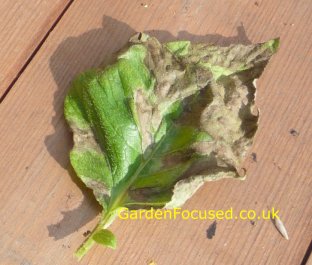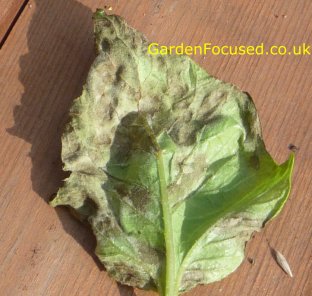The spores of the Potato Blight fungus are spread in the air and they can travel several miles. A less likely source of infection is through water. Potato Blight thrives in warm and damp conditions. When these conditions occur together for a couple of days or more then infection by potato blight is a distinct possibility. There are two standards which are used to determine if the conditions are correct for a blight infection, the Beaumont Period and the Smith Period. Both have relatively similar criteria, essentially warm and damp weather over a period of two days or more.
Those standards might be useful for professionals but a more practical predictor can come in the form of an email! Simply sign up to the free Potato Council blight predictor service, click here, and they will email you when those conditions are occurring in your area.

Top view of a leaf with potato blight
Click picture to enlarge
POTATO BLIGHT SYMPTOMS
The first sign of potato blight will be small, dark brown marks on the leaves. These will quickly increase in size and number. In many cases the stems of the plants will also have some brown marks on them. If you turn an infected leaf over you will see a light white layer of mould, these are the spores and these will be spread by wind.

Bottom view of a leaf with potato blight
Click to enlarge picture
If the potato tubers below ground are affected as well they will have dark marks on them. Take a potato from the ground and cut it in half. If it is infected with potato blight the flesh will be stained brown and it will have started to rot.
HOW TO PREVENT POTATO BLIGHT
First is cleanliness and hygiene, this will prevent the potato blight starting from your garden or allotment. Remove all traces of the plant and potatoes at the end of each season. If anything looks even remotely infected then burn it.
Store only potatoes in perfect condition and regularly inspect stored potatoes for signs of deterioration. Practice good crop rotation and buy seed potatoes only from certified suppliers as explained earlier.
Choose potato varieties which are naturally resistant to potato blight. See our page on pest and disease resistance potato varieties, click here. The top blight resistant potatoes are Setanta, Sarpo Axona and Sarpo Mira. Although they will resist most attacks of blight the not so good news is that they are not the most versatile potatoes. A mention must be made of Orla which also has good tuber blight resistance, not quite as high as the others but it can be grown as a first early.
If you grow potatoes in a greenhouse then they are much less likely to suffer from potato blight because the spores can’t reach them so easily. The problem with this though is that you will need to replace the soil every year to avoid the build up of other pests and diseases. One alternative is to grow potatoes in containers in the greenhouse (or temporarily move them there when blight is likely. See our page on growing potatoes in containers. You will be surprised at how many potatoes can be harvested from a couple of container fulls of potatoes.
If you use the Potato Council Blight Predictor service, click here, then you can take action before blight has significantly affected your potato crop. The recommended course of action is to spray your potato crop with either a Dithane 945 replacement (Dithane 945 is no longer available) or with Bordeaux Mixture. But before you do use these chemicals, remember that they are only partially effective and definitely only to be used before the Potato Blight infection is established.
The copper fungicide Bordeaux Mixture has previously been recommended as a spray to prevent canker in fruit trees. However it has now been withdrawn from sale in the UK. Currently there are no alternatives which have been scientifically proven to be anywhere near as effective as Bordeaux Mixture
Various alternatives are suggested, for example aspirin solution or milk, but none have been proven to have any effect.
TREATING POTATO BLIGHT
There is no cure for potato blight when your plants are infected. The first action to take is to cut off all growth above soil level and burn it as soon as possible. This will minimise the infection on your soil and also reduce the risk of you passing potato blight on to neighbours and that includes neighbouring farms. If the above ground growth has been removed early enough it is likely that the potatoes below ground will not have been affected by the potato blight, especially if you have previously earthed up your potato plants. Test the potato tubers by removing a couple from the ground.
If they are infected (see Potato Blight symptoms above) then your crop is beyond help and all potatoes should be dug up and burnt. Be thorough in doing this so that all trace of infected potato growth above and below the ground is removed.
If however your potatoes below ground have not been infected then they can be harvested as normal. Without the top growth they will no longer continue to grow but they will be fine to eat.
For those who are adventurous and willing to try something new, the link here is from the Independent and it claims that a couple of aspirin in 4.5 litres of water gives some protection against blight as far as potatoes and tomatoes are concerned. It may well be worth a try, after all, aspirin are very cheap.
POTATO BLIGHT
INTRODUCTION TO POTATO BLIGHT
By David Marks
Potato blight is caused by a fungus called Phytophthora infestans. It is transmitted by air, wind and soil. In the UK almost all the blight fungi on the soil surface are killed by the cold weather in the winter.
However, if potatoes are left underground over the winter, the fungus can easily survive. The other key source of infection are piles of potatoes in sacks or on the ground. Fungus in these potatoes can also survive the winter. Cleanliness is essential in preventing Potato Blight.